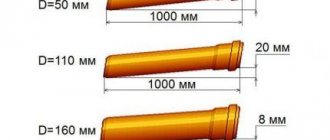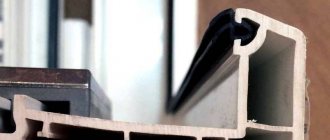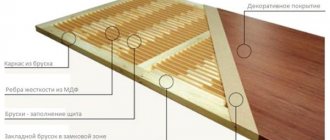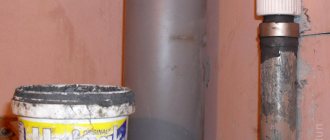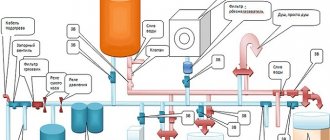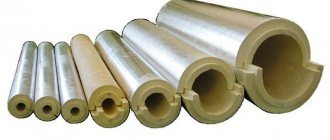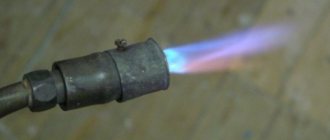Thanks to numerous advantages over metal ones, plastic pipes are rapidly conquering the construction market. Currently, it is difficult to find options for installing water supply systems with metal pipes in new buildings; modern materials have completely replaced traditional technologies.
Plastic pipes for water supply
Advantages of plastic pipes
- Excellent performance. The internal diameters of the pipes remain smooth throughout the entire period of use, corrosion pits do not appear on their surfaces, and solid contaminants are not deposited. As a result, water from plastic pipelines is much cleaner than from metal ones. For complete disinfection, a lower concentration of chlorine, which is harmful to the human body, is required.
- Light weight. The mass of plastic analogues of the same internal diameter is approximately five times less than metal ones. This is very important for multi-story construction, when water pipes require kilometers of pipes of various diameters.
Plastic pipes are much lighter than steel pipes
- Manufacturability. Installation does not require the use of complex tools and a welding machine; the work can be done by builders of average professional qualifications. Due to this, the estimated cost of installation work is reduced. There are options for complete assembly of plumbing systems using only threaded fittings.
- Duration of operation. Plastic reacts negatively only to hard ultraviolet rays. If the water pipelines are hidden, then the guaranteed service life reaches at least fifty years. This is the depreciation period for most buildings and structures.
Hidden installation of water supply from plastic pipes
Pipes are easy to transport; most loading/unloading operations can be performed manually without the use of expensive special equipment. They do not deteriorate their original characteristics even during long-term storage. Steel or cast iron pipes are covered with a layer of oxides, which creates significant difficulties during their installation.
Pressure products
It is difficult to imagine the functioning of a residential building or industrial building without polyvinyl chloride products. We are talking about one of the main areas of application of polyvinyl chloride (PVC) - the production of pipes, including pressure pipes, the main characteristics of which are specified in GOST R 51613-200.
Where are pressure pipes used?
These boners can be found everywhere. They are used in:
- water-technical structures;
- multi-scale water supply;
- construction;
- chemical, oil refining, food industries;
- agriculture.
Sewage systems are installed using a PVC pressure pipe. It is impossible to do without them when constructing treatment facilities. The products are ideal for installing water supply systems and for installing storm drains.
One of the main purposes of pipeline parts is pressure water supply, which means the presence of a whole complex of works on the installation of special devices to ensure a continuous supply of water. For this purpose, PVC risers pn are used, designed to operate at high pressures (from 6 atm. and above).
Pressure adhesive products with a diameter from 32 to 110 mm are widely used. They can be built on top of each other, glued together using couplings. In addition to couplings, bends, elbows, and taps can be used for adhesive joints.
Kinds
According to GOST, risers are produced:
- socket type (marking P), which are sealed when connected to similar products using a special type of sealing ring;
- with a socket (marking RK), designed for joining with other analogues for an adhesive connection;
- without bell.
Due to unplasticized polyvinyl chloride, pressure pipes made from this plastic are abbreviated as UPVC. Some experts believe that the first letter “H” means “pressure”. But this is incorrect, since “N” means unplasticized.
Advantages
Pressure pipes differ:
- low level of toxicity;
- self-extinguishing;
- tightness of connections;
- resistance to chemical influences;
- ease of installation;
- high throughput;
- light weight;
- long service life;
- budget price.
Water-pressure products are not afraid of overgrowing of walls both outside and inside. They do not corrode, crack, expand or contract. Therefore, uPVC products are the best option for constructing a water supply system.
These advantages significantly reduce the cost of laying a pipeline, which has a positive effect on the family’s financial expenses.
Types of plastic pipes
Currently, several types of pipes are produced, each with its own individual physical and operational properties.
| Types of pipes | Description of performance characteristics |
Polyethylene | Today they are not used very often and are considered obsolete, although the physical and operational parameters satisfy consumers. Can be used for installation of drinking and industrial water pipelines, the maximum pressure depends on the wall thickness. It is not recommended to heat to more than +40°C. Depending on the diameter, they are sold in coils or straight sections; special additives are added to improve the physical parameters. This increases resistance to UV rays, expands the temperature range, and increases ductility at sub-zero temperatures. Pipes with increased strength are manufactured using a new technology that allows individual high-molecular sections to be stitched together into three-dimensional structures. (PEH). Due to this, the ultimate stability increases with increasing temperature; such products are recommended for use during the creation of pipelines for transporting coolants. |
Polypropylene | Compared to polyethylene, plastic has improved technical parameters. The material is characterized by a low thermal conductivity coefficient, can operate at temperatures down to -75°C, and can withstand short-term heating up to +95°C. The pipes have different wall thicknesses; depending on the size, they can operate at pressures of 10, 16 and 20 atm. Companies produce special products designed for long-term operation under conditions of high temperatures and pressures, which have a durable reinforcing layer of polymer threads. Water pipelines are assembled using couplings and welding; the technology is very simple and reliable. The service life of welded joints does not differ from the service life of whole pipes. Innovative additives are used to increase resistance to harsh ultraviolet rays. Disadvantage - polypropylene pipes are less flexible, it is not advisable to install them while maintaining internal stresses. |
Polyvinyl chloride | They are characterized by improved mechanical strength characteristics, can withstand significant pressure, and are often used during the creation of main pipelines. It is not recommended to use at low temperatures; the sections are connected using fittings with rubber seals. Solid pipes are made from unplasticized polyvinyl chloride. Negative qualities include fragility; pipelines react negatively to sudden shock loads. |
Metal-plastic | The most expensive and most stable pipes consist of three layers firmly connected to each other. The inner one is made of cross-linked polyethylene. This polymer has a three-dimensional structure of molecular chains, which significantly improves physical characteristics. It does not lose its original strength values when heated to high temperatures, and does not release harmful chemical compounds into the water. The second layer of aluminum foil up to 0.5 mm thick takes on pressure at high water temperatures and critical values of internal stress. The third layer (outer) is made of high-density polyethylene. Used to protect two internal ones from mechanical damage. The pipes are connected by pressing - a rather complex method that requires sophisticated equipment. Pressing is done with special fittings. To facilitate installation, some pipes provide collet connections, but they are not durable and reliable. The pipes have the letter designation PEX-Al-PE. The first layer is cross-linked polyethylene, the second is made of aluminum, and the third is made of modified polyethylene. |
When choosing a specific pipe, you need to pay attention not only to the cost, but also to the performance characteristics and manufacturability of installation.
For water supply
The material used for the production of pipe products largely determines the quality and durability of the water supply system. Today, PVC pipes are used to lay water pipes. Why are these products so popular? The point is the positive qualities of the material.
Parts made of polyvinyl chloride differ:
- lack of toxic effects;
- strength;
- plasticity;
- wide range;
- low cost;
- long service life.
The ease of installation of PVC pipes for water supply, regardless of size, allows you to lay the pipeline yourself, which will save your family money.
Plumbing equipment stores and construction supermarkets sell plumbing plastic risers.
Classification and main characteristics
When installing cold water lines, products made of polyvinyl chloride (PVC) are used. Components for PVC water supply pipes must also be made of similar materials.
Ideally, plumbing pipes and PVC adapters for water pipes, fittings should be made not only from the same material, but also from the same manufacturer. In this case, the highway will function efficiently for decades.
These are the products of the famous French company Leroy Merlin, which produces sewer, plumbing products and fittings, shut-off valves, and other products for home improvement.
To organize the water supply, more often than others, they use PVC pressure pipes for water supply, the production of which is regulated by GOST R 51613-200.
Products are marked accordingly:
- standard size;
- bending radius;
- type of installation;
- working pressure.
For domestic needs, risers with a diameter of 25, 32, 50, 63 mm are most often used.
After plasticizers are removed from polyvinyl chloride, the material becomes safe and durable, and the elements made from it are called uPVC pipes. They may differ from each other not only in size, but also in color.
Products of gray and black shades are used for laying internal systems, orange (brown) - for external ones. Casing pipes have a blue or white tint.
PVC pipes are used in the construction of external sewer wells, thanks to which the presence and level of water runoff is controlled.
The diameter of PVC pipes for water supply is 9-630 mm, length is 1 m, 2 m, 3 m, 6 m. To obtain risers of a different length, you can cut the necessary pieces using special scissors.
To make a quality connection, you need to carefully clean the ends. Not everyone knows how to connect PVC pipes for water supply.
This procedure can be done using:
- couplings;
- flange;
- glue.
Often the risers are connected to each other in a socket. The socket joint is characterized by simplicity and speed of installation. This method is used to join polyethylene (PE) water pipes and other socketed plastic pipes.
Important!
Before making an adhesive connection, you need to check the joining parts for their compatibility. Algorithm for performing the work:
- Place the appropriate fitting on the main pipe.
- Cut off the required piece of pipe, clean the end, chamfer, blow, degrease.
- Coat the inner surface of the fitting (adapter) and the outer surfaces of the PVC pipes being connected with glue.
- Insert the section to be connected into the adapter, turn both ends of the pipes relative to the fitting by 1/3 of a turn to evenly distribute the adhesive, and secure the connection tightly.
If all elements are compatible, then after 25-35 seconds. the structure must be immovable. Wait 1 minute until the compound hardens completely.
Practical tips for use
Despite the high physical parameters of plastic pipes, the warranty period can only be maintained if the manufacturer's recommended rules of use are followed.
- Pressure. Regardless of the material of manufacture and wall thickness, for all types of pipes the maximum pressure is limited to 6 atm. This is quite enough for one-story houses, but in multi-story buildings it is necessary to use more durable materials.
- The heating temperature should not exceed +95°C. This applies only to the most durable metal-plastic pipes; for all others, the maximum short-term heating is within +75°C.
- During installation, thermal expansion parameters must always be taken into account. When the material is heated by 60°, one linear meter increases in length by 9 mm. These are very large values; when installing pipelines, always provide for the possibility of compensation. Some straight sections can reach ten meters or more.
Technical characteristics of metal-plastic pipes
After installation is completed, the quality of the structure must be checked by pressure, and the actual value must exceed the maximum calculated by at least 30%.
Raw materials to support production
For a continuous production cycle, a stable supply of raw materials should be established. It consists of polymers (polyethylene, polybutylene, polyamide, polyvinyl chloride, polypropylene), which are supplied in granular form. The packaging must necessarily indicate the name of the product, its type, expiration date, manufacturer and other data that allows you to obtain comprehensive information about the raw material. The manufacturer is required to provide product certificates.
Important: high-tech pipes can be obtained exclusively from primary processing granules (on average 80 rubles/kg). The use of recycled materials (on average 30-40 rubles/kg) is allowed only for low-pressure pipes (LDPE).
It is better to enter into a supply agreement with large manufacturers of polymer granules. In the domestic segment, these are RosEcoPlast LLC, Polymer Club LLC, AST Promplast LLC, TPK GlavTehProm, TD Plas LLC and a number of others. To simplify logistics, you should look for a partner in your region. However, offers from companies in remote areas can be no less profitable.
How to solder plastic pipes
To install the pipeline system, you need to purchase a special welding machine; its cost depends on the manufacturer. Professional plumbers need to have reliable and high-quality tools; if you only work on pipelines at home, then it’s enough to buy a cheap Chinese craft.
Welding set
The kit includes a soldering iron with a stand. Please note that the soldering iron can be fixed on the stand in two positions; this is sometimes required when welding pipes in hard-to-reach places.
Soldering iron for polypropylene pipes
There are scissors for cutting plastic pipes and nozzles for heating external and internal surfaces. The attachments are screwed to the soldering iron with a hex wrench, which is also included in the kit. The diameter of the heating elements is 20 mm, 25 mm, 32 mm and 40 mm. At home, nozzles of 20 and 25 mm are most often used, 32 mm are very rarely used, and 40 mm are almost never used. A tape measure is included for marking.
Step 1
. Place the soldering iron on the supply and plug it into the mains. There is a control panel on the handle indicating the heating temperature; while the tool is being prepared, screw on the nozzles of the appropriate diameter.
Preparing the soldering iron for use
Practical advice. The soldering iron has two technological places for fixing the attachments: at the end and in the middle. For simple welding, the screwing location does not matter. But according to the instructions, there are differences. If you plan to weld pipes only on the assembly table, then the nozzles must be screwed in the middle of the soldering iron.
Why?
- The elements warm up much faster to the temperatures set by the thermostat. In addition, in this place the indicators are the most accurate.
- The soldering iron is more stable, which increases safety of use. When pushing/removing pipes from the nozzles, significant lateral forces arise; inexperienced craftsmen may have the soldering iron tip over.
During the installation of pipelines, situations arise when the fitting is already installed on a pipe attached to the wall, and another section needs to be welded to it. Heating must be done directly on the pipeline; the soldering iron must be kept at a minimum distance from the wall. For such cases, the nozzles must be attached to the end of the pole. Beginners should follow the recommendations; professionals always fix the attachments at the end and do not waste time twisting them.
Step 2
. Set the heating temperature to +250°C.
Soldering iron temperature regulator
But this value is rather arbitrary for several reasons.
- Firstly, the figures vary greatly depending on the welding manufacturer. With Chinese units, it can change even with constant long-term operation, no one can explain the reason.
- Secondly, heating depends on the quality of the plastic pipes, and there are also differences here.
- Thirdly, the master himself determines the degree of heating by eye; he pays attention to the melting rate and consistency of the plastic. Practice shows that it is always better to set the initial temperature to +250°C, and then adjust it as necessary.
Important. It takes time to heat the soldering iron evenly along its entire length and the nozzles. It is recommended to wait until the unit turns on and off twice, during which time all its elements will have the same parameters.
Never forget about safety precautions. If you work with heated surfaces, protect your hands with gloves.
Step 3
. Use a pencil to mark the heating length on the pipe.
Warm-up length mark
To do this, you need to know how deep it goes into the fitting. Experienced craftsmen recommend not heating to the maximum length, but leaving them cold for about 2–3 mm, heating for 13–15 mm. The fact is that if the heated section is too long, then during the connection the soft end bends and significantly reduces the internal diameter of the pipe. The consequences of this phenomenon are not critical, but rather unpleasant. It all depends on how many incorrect connections you have in total and how the diameter decreases in total. It is better to use a pencil because the marks can then be removed without any problems. They look very ugly on the finished pipeline.
Step 4
. Insert both parts into the attachments at the same time. It is recommended to perform all actions synchronously; inserting and removing elements must be done simultaneously as much as possible. Press them firmly against the pads; turning them during heating is not recommended. Although this does not have a noticeable negative effect on the welding strength.
Warming up the pipe and fitting
Step 5
. Wait for about five seconds, remove from the attachments and connect the parts.
Soldering temperature and time
There is no need to rush, you have about ten seconds left. During this time, you can safely align the elements; they should be located strictly along the same axis.
Connecting elements
Soldering plastic pipes is not considered a technologically complex process, but if you have any concerns, you can practice a little on sections. Couplings and angles cost pennies, there will be no financial losses.
Video - How to solder polypropylene pipes
Production room
To locate the enterprise, you will need a building with a workshop, the area of which corresponds to the dimensions of the production line, plus warehouses for storing raw materials and finished products, office and household areas. The building must contain all the necessary communications and convenient access roads for large vehicles. Ceiling height – at least 4 m.
A separate requirement is the ability to control humidity levels. Exceeding this parameter negatively affects the quality of the finished product.
Cross-linked polyethylene
Polyethylene material is used for hot water supply. The connection can be either fitting or compression.
Advantages:
- flexible structures;
- the bay allows installation without joints;
- the structure does not deform or collapse when in contact with solvents, chemicals, gasoline;
- the maximum permissible temperature of the working fluid and coolant is up to +75°C.
If all requirements are met, the material will last about 40-50 years. Disadvantages include destruction of the structure when exposed to ultraviolet rays. The main difference is the small diameter. The material cannot maintain an even shape, so the products are practically not used for open laying. They are presented in the middle price category.
Product certification
In order to confirm compliance of product parameters with reliability and safety requirements, it is necessary to obtain a GOST certificate of conformity for plastic pipes (Federal Law “On Technical Regulation”). Bodies accredited to issue relevant certificates have the right to carry out the procedure.
Examples:
- GOST R 32415-2013 “Thermoplastic pressure pipes and connecting parts for them for water supply and heating systems. General specifications".
- GOST 18599-2001 “Polyethylene pressure pipes. THAT".
During the inspection, plastic pipes are tested for resistance to gases, temperature changes, hydrostatic pressure, tensile deformation, and maximum load values. By the time the certification procedure begins, the entrepreneur must have samples made on his own equipment (you can order the production of samples from the equipment supplier).
Investment size
To open production you will need about 8-10 million rubles. This will include costs for the purchase and commissioning of equipment (2-5 million rubles), registration of an enterprise, development of technological maps, rental of premises and salary fund for six months, purchase of raw materials, repair work and connection of communications, purchase of freight vehicles, additional mechanisms and consumables, as well as unforeseen expenses.
The calculation of profitability is based on the production capacity of the enterprise, product range, and the presence of stable sales markets.

